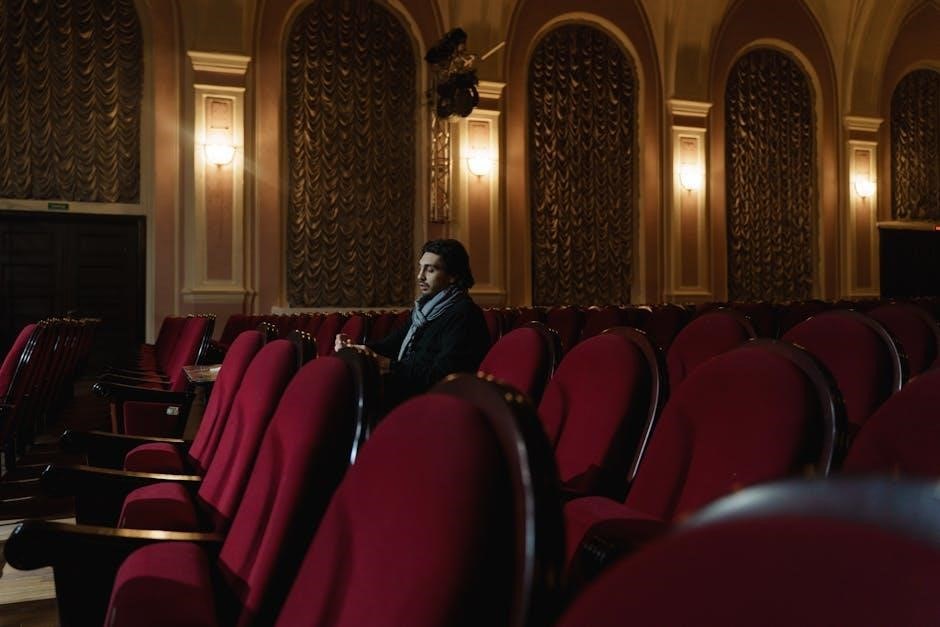Into the Woods Script PDF: A Comprehensive Guide
Welcome! This guide provides a comprehensive overview of accessing and understanding the “Into the Woods” script PDF. We’ll explore where to find it, delving into its authorship and key elements.
Availability of the Script
The “Into the Woods” script is generally available, but access often depends on its intended use. For performance purposes, acquiring the script usually involves licensing agreements. These agreements are crucial to respect copyright laws and ensure that the creators are properly acknowledged and compensated for their work.

Several online platforms offer the script for reading or download, sometimes freely for educational use or study. However, producing the play requires obtaining rights from Musical Theatre International (MTI), the primary licensing agent. MTI provides the official script and vocal scores necessary for a legitimate production.
Be aware of unauthorized copies circulating online, as these infringe copyright. Always seek official sources to ensure the script’s accuracy and legality.
Where to Find the “Into the Woods” Script PDF
Locating the “Into the Woods” script PDF requires exploring both official and educational avenues. Musical Theatre International (MTI) is the primary source for legally obtaining the script for production purposes. Their website offers licensing and script purchase options upon securing the rights to perform the musical.
Educational institutions sometimes provide script excerpts or full scripts for academic study. These are often found within library databases or course-specific online portals. Websites dedicated to musical theatre enthusiasts may also host script PDFs for reading and analysis, though verifying their legitimacy is crucial.
Be cautious of unofficial sources offering free downloads, as these may violate copyright laws or contain inaccurate versions. Prioritize MTI or reputable educational platforms for obtaining the script.
Official Sources for the Script
The most reliable source for acquiring the “Into the Woods” script is Musical Theatre International (MTI), the licensing house that holds the performance rights to the musical. MTI provides the official script as part of their licensing package when a theatre group or school secures the rights to perform the show.
Purchasing the script directly from MTI or an authorized vendor guarantees that you receive a legally obtained and accurate version. This is especially important for productions, as using unauthorized scripts can lead to copyright infringement issues.
While some academic institutions might have legitimate copies for educational purposes, MTI remains the definitive source for performance scripts and related materials;
Musical Theatre International (MTI) Licensing
Musical Theatre International (MTI) is the primary licensing agency for “Into the Woods.” Securing performance rights through MTI is essential for any theatrical production. This involves an application process where you provide details about your organization, venue, and planned performance dates.
MTI offers various licensing packages that include the script, vocal scores, and other necessary materials. The cost of the license depends on factors such as the size of your audience and the number of performances. Obtaining a license ensures that you are legally authorized to perform the show and respects the intellectual property of the authors.
Remember to apply for the license well in advance of your production to allow sufficient time for processing and material delivery.

Understanding the “Into the Woods” Script
Delving into the script reveals the genius of Stephen Sondheim and James Lapine. Discover the interwoven fairy tales, character roles, and the narrative’s profound exploration of wishes and consequences.
Authorship: Stephen Sondheim and James Lapine
The magic of “Into the Woods” stems from the remarkable collaboration between Stephen Sondheim, who crafted the music and lyrics, and James Lapine, the playwright responsible for the book. Their combined genius birthed a theatrical masterpiece.
Sondheim’s intricate musical compositions and lyrical wit perfectly complement Lapine’s clever narrative structure, intertwining classic fairy tales in a fresh and thought-provoking manner. Their work together created a synergy.
Lapine’s skill in weaving together the storylines and Sondheim’s ability to infuse each character with depth through song, makes the script a treasure. This Tony Award-winning play showcases their talent. The partnership is renowned. Together, the duo crafted a legacy.
Their storytelling is timeless, resonating with audiences for generations. The script bears the mark of two distinct creative voices.
The Intertwining of Fairy Tales
“Into the Woods” masterfully weaves together the narratives of several iconic fairy tales, creating a rich and complex tapestry. Cinderella, Jack (of beanstalk fame), Little Red Ridinghood, and the Baker and his Wife all find their stories colliding within the enchanted woods.
This innovative approach allows the musical to explore universal themes of wishes, consequences, and the complexities of life beyond “happily ever after.” The characters’ individual quests intertwine, impacting each other’s fates and revealing the interconnectedness of their worlds.
The script cleverly juxtaposes the familiar elements of these tales with original plotlines, adding layers of depth and subverting expectations. This creates a unique and engaging experience for audiences familiar with these stories. The blending is seamless.
Exploring the characters’ desires and the moral lessons learned is central to the script. This reimagining of classic stories offers a fresh perspective.
Key Characters and Their Roles

“Into the Woods” features a diverse cast of characters, each with a distinct role to play in the unfolding drama. These figures, drawn from classic fairy tales, are central to the script’s exploration of ambition, consequence, and the search for happiness.
Cinderella, yearning for a life beyond her stepmother’s cruelty, embarks on a journey of self-discovery. Jack, driven by poverty and naiveté, seeks fortune in the sky. Little Red Ridinghood, innocent yet resilient, confronts the dangers lurking in the woods.
The Baker and his Wife, burdened by a curse and longing for a child, represent the desire for fulfillment. These main characters, along with witches and princes, interact in complex ways. Their desires bring conflict.
The Narrator guides the audience. Each character’s journey contributes to the musical’s overall themes, offering insights into the human condition. Their interactions drive the plot forward.
The Baker and His Wife
The Baker and his Wife are pivotal characters within “Into the Woods,” representing the yearning for a family and the lengths one will go to achieve it. Their journey begins with the revelation that they are childless due to a witch’s curse, setting them on a quest into the enchanted woods. They are tasked with gathering specific items to reverse the spell.
The Baker, often portrayed as timid and indecisive, relies on his Wife’s resourcefulness and determination. She is the driving force behind their mission, exhibiting courage and practicality. Throughout their adventure, they encounter other fairy tale figures, whose stories intertwine with their own, testing their morality and resolve.
Their relationship evolves as they face challenges, highlighting themes of partnership, sacrifice, and the complexities of fulfilling one’s desires. They must learn to trust each other.
Cinderella
Cinderella, a classic fairy tale character, adds a layer of yearning and self-discovery to “Into the Woods.” She embodies the dream of escaping a difficult life and finding true happiness; Her journey starts with mistreatment from her stepmother and stepsisters, leading to her iconic wish to attend the King’s festival. With the aid of a magical intervention, she achieves her dream, capturing the Prince’s attention.
However, Cinderella’s story in “Into the Woods” explores beyond the traditional happily ever after. She grapples with indecision and the complexities of choice. The musical highlights her internal conflict between her desire for freedom and the allure of a seemingly perfect life with the Prince.
Cinderella’s character arc emphasizes independence, reflecting on the true meaning of happiness and self-reliance, challenging the idea that fulfillment relies on external validation or a Prince’s love.
Jack (and the Beanstalk)
Jack, the adventurous protagonist from “Jack and the Beanstalk,” represents youthful innocence and impulsive decision-making within “Into the Woods.” He is portrayed as a naive young boy who trades his family’s cow for magic beans, hoping for a better life. This act, born from desperation and a lack of understanding, sets off a chain of extraordinary events that significantly impact the story’s overarching narrative.
His climb up the beanstalk and encounters with the Giant and his wife introduce themes of consequence and moral ambiguity. Jack’s actions, driven by a desire to help his mother, result in theft and, ultimately, the death of the Giant. The musical explores the ethical implications of his deeds, questioning whether the ends justify the means.
Jack learns valuable lessons about responsibility and the weight of his decisions, maturing from an innocent boy to a young man aware of his actions’ repercussions.
Little Red Ridinghood
Little Red Ridinghood embodies youthful bravado and naive confidence as she journeys through the woods to visit her grandmother. Her encounter with the Wolf is a pivotal moment, highlighting the dangers lurking beneath the surface of seemingly innocent situations. Initially, she is portrayed as carefree and trusting, easily deceived by the Wolf’s cunning disguise.
However, her experience transforms her, fostering a newfound sense of self-reliance and resilience. Emerging from the Wolf’s belly, she is no longer the same innocent girl. She becomes more assertive and aware of the world’s potential threats, learning to protect herself and others. Her red cape, once a symbol of youthful innocence, evolves into a badge of survival and experience.
Little Red Ridinghood’s character arc underscores the loss of innocence and the acquisition of wisdom through facing adversity, contributing to the musical’s exploration of maturation and moral complexity.

Exploring the Libretto
The libretto of “Into the Woods,” crafted by James Lapine, is more than just words. It’s a complex tapestry of interwoven narratives. It provides a deep understanding of the story.
Complete Libretto Access
Gaining access to the complete libretto of “Into the Woods” is crucial for anyone involved in studying, performing, or simply appreciating the musical. Several online platforms and theatrical resources offer the script in PDF format. Sites like Scripts.com may host user-uploaded versions. However, always prioritize obtaining the script from official sources, such as Musical Theatre International (MTI), the licensing house for the show, ensuring copyright compliance.
Educational institutions often provide access to the libretto through their libraries or drama departments. Remember to respect copyright laws and licensing agreements. The complete libretto allows for a thorough analysis of the characters, plot, and themes woven throughout Sondheim and Lapine’s masterpiece. It’s the foundation for a deeper understanding.
Educational Purposes of Available Scripts
The availability of “Into the Woods” scripts, particularly in PDF format, serves significant educational purposes. Students and educators can utilize the script for detailed character analysis, exploring the motivations and development of figures like the Baker, Cinderella, and Little Red Ridinghood. Examining the script facilitates discussions about the intertwining of fairy tales and the musical’s broader themes, such as wishes, consequences, and the complexities of life.

Furthermore, the script is invaluable for studying Sondheim’s lyrical genius and Lapine’s narrative structure. Aspiring playwrights and composers can learn from their innovative approach to storytelling. The “Into the Woods” script acts as a vital tool for promoting theatre appreciation.
The Prologue: Setting the Stage
The prologue of “Into the Woods” is a masterclass in efficiently setting the stage. It swiftly introduces the main characters, each entangled in their own fairy tale predicament. Cinderella yearns to attend the festival, Jack desires his cow to provide milk, and the Baker and his Wife desperately wish for a child. Little Red Ridinghood is simply on her way to grandmother’s house.
This initial segment expertly weaves together these disparate narratives, hinting at their interconnectedness and the journey that awaits them. The prologue establishes the core themes of the musical, highlighting the characters’ desires and the lengths they will go to achieve them. It is a crucial section for understanding the entire story.

“Into the Woods” JR. Script
The “Into the Woods” JR. script caters to middle school performers. This adaptation offers a streamlined version, perfect for younger actors and audiences, while retaining the original’s charm.
Middle School Adaptation
The “Into the Woods” JR. adaptation is specifically designed for middle school students. This version simplifies the complex themes and shortens the runtime, making it accessible and engaging for younger performers and audiences. The script retains the core storyline and memorable musical numbers while removing some of the darker or more mature elements present in the original production.
This adaptation focuses on key characters and their journeys, emphasizing the importance of community and the consequences of one’s actions. The musical vocabulary is maintained, offering a challenging yet achievable experience for budding vocalists. The JR. script provides a fantastic opportunity to introduce middle schoolers to musical theatre.
Furthermore, the licensing for the JR. version may differ, potentially offering more affordable options for school productions. This adaptation ensures the magic of “Into the Woods” can be shared with a younger generation, fostering a love for the performing arts;

Audition Resources and Scripts
When preparing for “Into the Woods,” audition resources and scripts are vital. Many websites offer excerpts from the script, including monologues and scenes suitable for auditions. These resources often include character descriptions and performance suggestions to help actors prepare compelling interpretations.
For the JR. adaptation, specific audition scripts are available, tailored for middle school performers. These scripts feature age-appropriate material and shorter scenes. Vocal scores and practice recordings can also be found online, aiding singers in mastering the musical numbers.
Websites and online communities often host audition central pages with helpful tips, character breakdowns, and sample audition sides. Accessing these resources can significantly enhance an actor’s preparation, boosting confidence and increasing their chances of landing a role in “Into the Woods.” Remember to check for copyright restrictions before using any material for performance.

Using the Script for Productions
Producing “Into the Woods” involves careful planning. Key considerations include casting choices, imaginative staging, and managing musical complexities. Utilizing the script effectively ensures a captivating and faithful rendition of this beloved musical.
Casting Considerations
Casting “Into the Woods” requires careful attention to vocal abilities and acting range, given the musical’s complexity. Finding performers who can handle Sondheim’s intricate melodies is crucial. Consider actors who embody the essence of their fairy tale characters, blending humor with emotional depth.
The Baker and his Wife demand strong chemistry and acting prowess. Cinderella needs a soprano with a touch of vulnerability. Jack requires youthful energy and a clear tenor voice. Little Red Ridinghood needs confidence and sharp delivery. The Witch needs a powerful stage presence and vocal command.
Evaluate auditionees based on their understanding of the characters’ motivations. Prioritize those who connect emotionally with the material. Encourage creativity in interpretations while staying true to the script’s intent. Remember, diverse casting choices can enhance the production’s appeal and resonate with modern audiences.
Staging and Set Design

Staging “Into the Woods” requires a versatile set capable of transforming from a whimsical forest to interior scenes. Prioritize creating a sense of depth and mystery, using lighting to shift moods. The woods should feel both enchanting and slightly ominous, reflecting the characters’ journeys and challenges.
Consider incorporating multi-level platforms to create visual interest and facilitate character interactions. Utilize trees and foliage to establish the forest setting, ensuring they don’t obstruct sightlines. A central, adaptable space can serve as various locations, such as the Baker’s house or Cinderella’s home.
Props should be carefully chosen to reflect the fairy tale elements, while remaining functional for the actors. The design should support the storytelling, enhancing the audience’s immersion in the magical world. Practical solutions for entrances and exits are essential for maintaining the play’s pace and flow.
Musical Numbers and Vocal Scores
“Into the Woods” features a complex and dynamic score by Stephen Sondheim. Accessing the vocal scores is vital for cast preparation. These scores provide the melodies, harmonies, and rhythms that bring the characters’ emotions to life. Familiarizing singers with their parts early in the rehearsal process is crucial.
Key musical numbers like the Prologue, “Giants in the Sky,” and “No One Is Alone” require careful attention to detail and vocal nuance. The vocal scores offer guidance on tempo, dynamics, and phrasing, enabling performers to deliver compelling interpretations. Understanding the musical context enhances the storytelling.
Consider utilizing practice recordings to assist singers in learning their parts. These resources can be invaluable for mastering the intricate harmonies and rhythms. A well-prepared cast ensures a captivating and emotionally resonant performance of Sondheim’s masterful score, bringing depth to the characters’ journeys.
